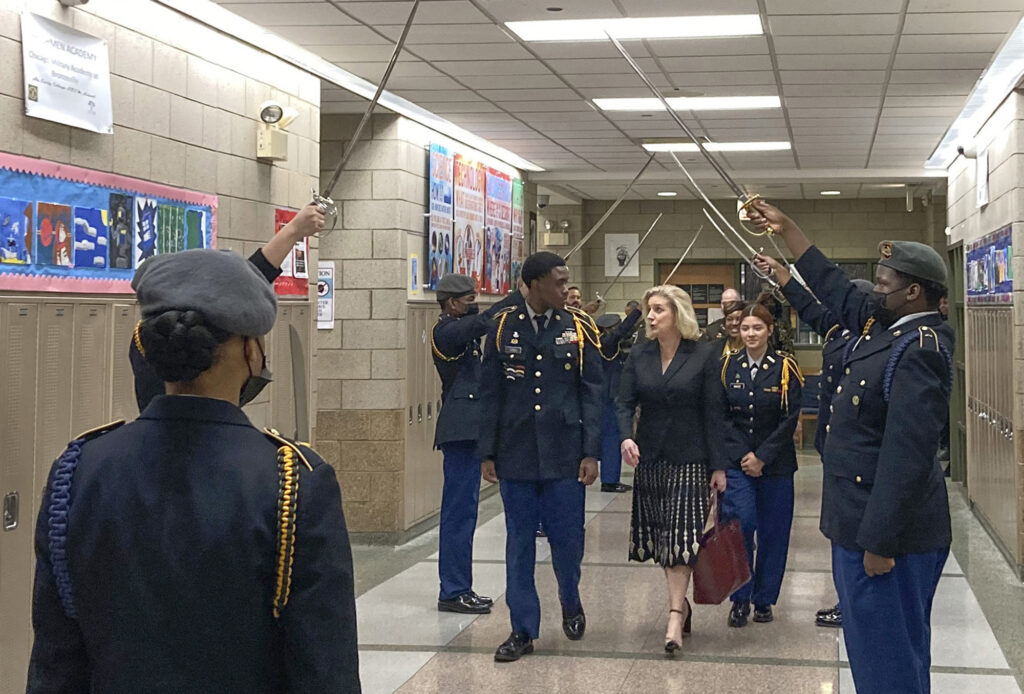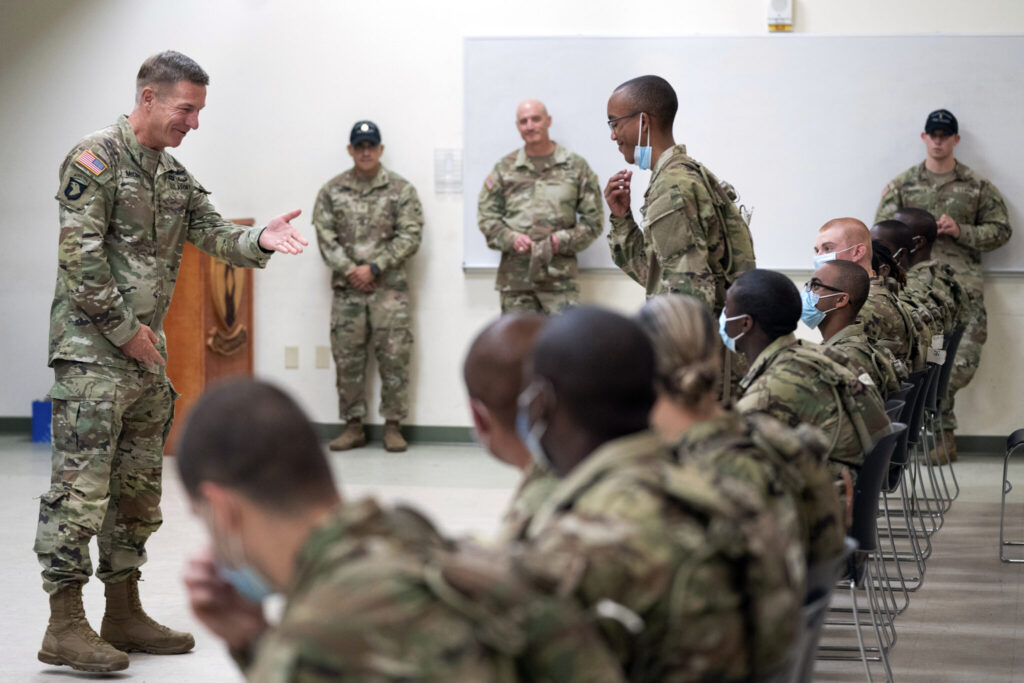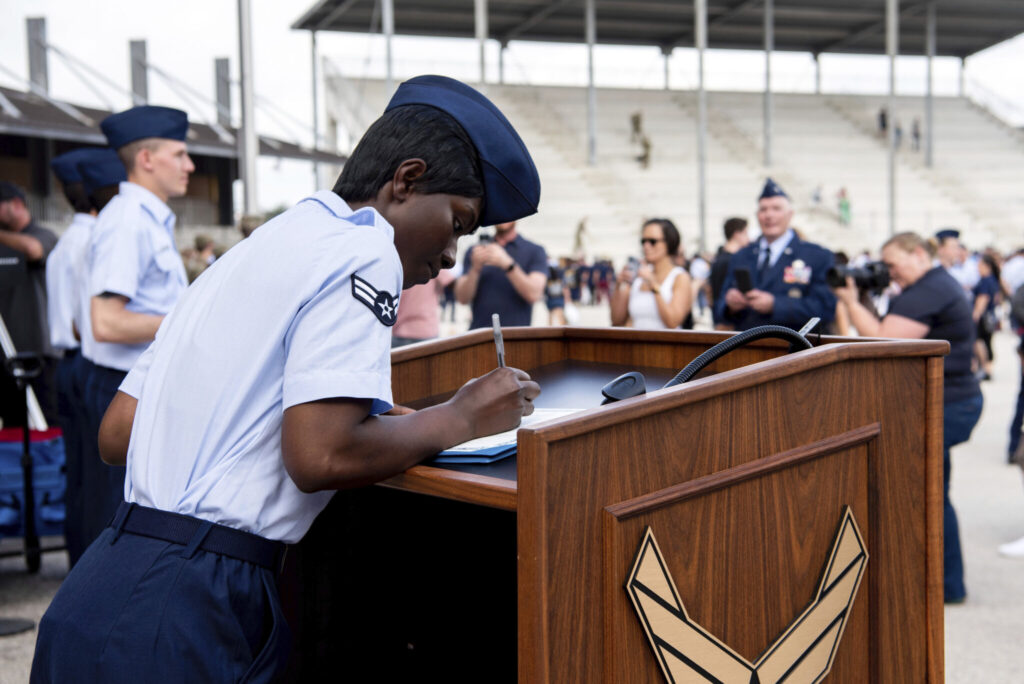After several difficult years, the Army and Air Force say they are on track to meet their recruiting goals this year, reversing previous shortfalls using a swath of new programs and policy changes. But the Navy, while improving, expects once again to fall short.
Quick Read
- Recruiting Progress in Military Branches: The Army and Air Force are reporting positive strides towards meeting their recruiting goals for the year, a turnaround from previous shortfalls. This success is attributed to new programs and policy adjustments aimed at expanding eligibility and preparation for new recruits.
- Navy Continues to Struggle: Despite improvements, the Navy is again projected to fall short of its recruiting target by a significant margin. New strategies, including a prep course and lowering academic standards for enlistment, have been implemented to address this issue.
- Economic and Recruitment Challenges: All branches are facing difficulties in competing with civilian job markets that offer competitive pay and benefits without the demands of military service. This environment complicates efforts to attract young people who meet the stringent physical, mental, and moral standards of the military.
- Innovative Recruitment Strategies: The Army has introduced a “future soldier prep course” which has significantly improved recruit preparedness for basic training and leadership roles. The Air Force has relaxed certain policies, such as tattoo regulations, and increased enlistment bonuses to attract more recruits.
- Navy’s Operational Challenges: The Navy’s recruiting shortfalls are impacting its operational capabilities, with a significant deficit in the number of sailors needed for both sea and shore-based assignments. This is particularly critical as Navy ships face ongoing threats in strategic locations like the Middle East.
- Marine Corps and Space Force: While the Marine Corps has managed to meet its recruitment numbers, it has occasionally had to dip into its pool of delayed entry recruits. The Space Force has consistently met its recruitment targets.
- Long-term Recruiting Strategies: The services are not only focusing on meeting immediate recruitment goals but also on transformative changes to their recruitment approaches. This includes professionalizing recruitment roles and offering new incentives, like allowing recruits to choose their first duty station, to attract and retain talent.
- Overall Military Recruitment Outlook: With six months left in the recruiting year, there is cautious optimism about meeting goals, bolstered by the successes of newly implemented programs and the upcoming high season for recruitment during the spring and summer months.
The Associated Press has the story:
New recruiting programs put Army, Air Force on track to meet enlistment goals
Newslooks- WASHINGTON (AP) —
After several difficult years, the Army and Air Force say they are on track to meet their recruiting goals this year, reversing previous shortfalls using a swath of new programs and policy changes. But the Navy, while improving, expects once again to fall short.
The mixed results reflect the ongoing challenges for the U.S. military as it struggles to attract recruits in a tight job market, where companies are willing to pay more and provide good benefits without the demands of service and warfighting. And even those who are meeting their goals say they are still finding it difficult to attract the dwindling number of young people who can meet the military’s physical, mental and moral standards.
With half a year to go in the recruiting year, Army Secretary Christine Wormuth said she is optimistic about hitting the 55,000 enlistment goal and getting an additional 5,000 recruits for the delayed entry pool that would come in during the next year or so.

“Right now we are 5,000 contracts ahead of where we were compared to this time last year,” Wormuth said in an interview with The Associated Press. “I don’t want to set expectations too high right now, but I’m feeling good.”
For the Army, it is a bright spot in what has been a long slog of low numbers and lengthy deliberations on how to reverse the momentum.
Last fiscal year, which ended Sept. 30, the Navy, Army and Air Force all failed to meet their recruitment goals. The Marine Corps and the tiny Space Force have consistently hit their targets, although the Marines have struggled a bit. The previous fiscal year, the Army fell 15,000 short of its enlistment goal of 60,000, and the other services had to dig into the pools of delayed entry candidates in order to meet their recruiting numbers.

Now, with six months of recruiting under their belts — including the historically meager winter months — the Air Force and Army are optimistic they’ll meet their goals.
A key success, said Wormuth, has been the Army’s future soldier prep course, which has graduated about 17,000 soldiers since it was started in August 2022, including about 5,300 so far in this current fiscal year. The prep course, which is now at Fort Jackson, South Carolina, and Fort Moore, Georgia, gives lower-performing recruits up to 90 days of academic or fitness instruction to help them meet military standards and go on to basic training.
“Not only are the graduation rates very high, but the number of graduates from the program who then are selected for leadership roles when they’re in basic training or who do particularly well in basic is notable,” said Wormuth, adding that 34% of the leadership posts in basic training are filled by soldiers who attended the prep course.
“We still have six months to go, so I don’t want to be overconfident,” said Wormuth. But recruiting was high in February and March, usually the most difficult months. “Now we’re starting to move into the spring and summer months, which are the traditionally better recruiting months.”

The Air Force is also upbeat, after making a number of policy changes, relaxing tattoo rules, boosting bonuses and expanding efforts to recruit lawful permanent residents. The service missed its active-duty recruiting mission of more than 26,800 last year by about 3,000 airmen, but has exceeded its goal so far this year. Buoyed by the progress, the Air Force has just increased its active-duty enlistment target for the year to 27,100, a boost of about 1,200.
Brig. Gen. Christopher Amrhein, who heads the Air Force’s recruiting, said while he’s “cautiously optimistic” about making their goal, “we cannot take our foot off the gas.” He said the service needs to keep looking at policy changes and other adjustments.
Navy leaders, however, say that while they’re doing better than last year, they expect to miss their recruiting goal of about 40,600 by roughly 6,700.
“We continue to face challenges in the current and forecasted economic environment and tough labor market,” said Vice Adm. Rick Cheeseman, head of Navy personnel. “The Navy continues to explore and evaluate new methods for attracting qualified, motivated and capable applicants.”

The Navy has started its own recruit prep course, and earlier this year began to enlist people who didn’t graduate from high school or get a GED, as long as they score 50 or above (out of 99) on the Armed Services Qualification Test. It was the second time in about a year that the Navy opened the door to lower-performing recruits. In December 2022 it started recruiting a larger number of sailors who scored very low on the test.
Adm. Lisa Franchetti, chief of naval operations, made clear last week that the recruiting challenges are having a direct impact on the Navy’s maritime mission. She told Congress that the Navy is about 18,000 short of the number of sailors needed for operations at sea, and about 4,000 short for shore-based jobs.
The bulk of those would be filled by incoming recruits, and the shortfall comes as Navy ships in the Middle East are under persistent pressure, countering attacks by the Iran-backed Houthis in Yemen.
The Marine Corps, meanwhile, hasn’t missed its enlistment goal, but did have to tap into its pool of delayed entry recruits in order to meet the target two years ago.
“We continue to make mission without ever diminishing our standards,” Gen. Eric Smith, commandant of the Marine Corps, flatly told Congress earlier this month. The Corps is on pace to meet this year’s goal of 31,100, including active duty and reserves.
The other services have begun to duplicate what has been a longstanding Marine program — the use of high-performing service members and up-and-coming commanders to serve as recruiters.
Army leaders have begun an extensive reorganization of its recruiting force, creating a professional job classification and doing reviews to weed out recruiters who aren’t doing well and would be better off in another job. And the service is finding other perks that work.
For example, about 25% of new recruits are opting to choose their first duty station, according to Gen. Randy George, chief of staff of the Army. Until recently recruits did not have that option. The key, said Wormuth, is figuring out which incentives work.
Right now, she said, the Army is trying to juggle both the short-term enlistment goals and the long-term changes in how the service recruits.
“The biggest challenge is maintaining our focus on making this year’s mission, keeping all of the wheels turning that we already have set in motion while at the same time building out the more transformational work that we’re doing,” said Wormuth. “We’re building the plane while it flies.”






